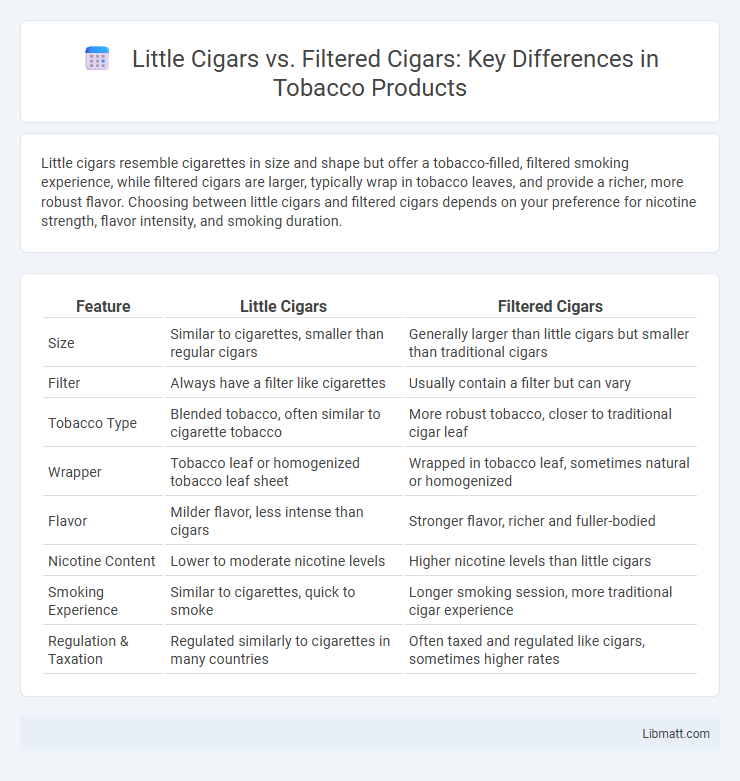Little cigars resemble cigarettes in size and shape but offer a tobacco-filled, filtered smoking experience, while filtered cigars are larger, typically wrap in tobacco leaves, and provide a richer, more robust flavor. Choosing between little cigars and filtered cigars depends on your preference for nicotine strength, flavor intensity, and smoking duration.
Table of Comparison
| Feature | Little Cigars | Filtered Cigars |
|---|---|---|
| Size | Similar to cigarettes, smaller than regular cigars | Generally larger than little cigars but smaller than traditional cigars |
| Filter | Always have a filter like cigarettes | Usually contain a filter but can vary |
| Tobacco Type | Blended tobacco, often similar to cigarette tobacco | More robust tobacco, closer to traditional cigar leaf |
| Wrapper | Tobacco leaf or homogenized tobacco leaf sheet | Wrapped in tobacco leaf, sometimes natural or homogenized |
| Flavor | Milder flavor, less intense than cigars | Stronger flavor, richer and fuller-bodied |
| Nicotine Content | Lower to moderate nicotine levels | Higher nicotine levels than little cigars |
| Smoking Experience | Similar to cigarettes, quick to smoke | Longer smoking session, more traditional cigar experience |
| Regulation & Taxation | Regulated similarly to cigarettes in many countries | Often taxed and regulated like cigars, sometimes higher rates |
Overview: Little Cigars vs Filtered Cigars
Little cigars resemble cigarettes in size and shape but typically have a tobacco wrapper, while filtered cigars are larger and wrapped in natural tobacco leaves with an added filter for smoother inhalation. Both options differ in nicotine content and flavor intensity, with filtered cigars often providing a stronger, richer taste. Understanding these distinctions helps you choose the right product based on your preference for size, taste, and smoking experience.
Size and Shape Differences
Little cigars are typically smaller, measuring 3-4 inches in length with a diameter similar to cigarettes, while filtered cigars often resemble regular cigarettes but are slightly larger in diameter and length, generally around 4-5 inches. Little cigars have a cylindrical shape with a tightly wrapped tobacco leaf or homogenized tobacco paper, whereas filtered cigars include a cigarette-like filter tip made from cellulose acetate. The size and shape differences influence smoking duration, flavor intensity, and user preferences between little cigars and filtered cigars.
Tobacco Blend and Flavor Profiles
Little cigars typically use a blend similar to cigarettes, often featuring milder, homogenized tobacco that offers a smooth and less intense flavor profile. Filtered cigars tend to incorporate a richer, fuller-bodied tobacco blend, providing a more robust and complex taste with deeper notes of earth, spice, and sweetness. Your choice between little cigars and filtered cigars will depend on whether you prefer a lighter, more cigarette-like experience or a stronger, traditional cigar flavor.
Filter Construction and Design
Little cigars typically feature a cellulose acetate filter similar to cigarettes, designed to reduce tar and nicotine inhalation, enhancing smoke smoothness while maintaining compact size. Filtered cigars, on the other hand, often incorporate denser filters with specialized filter tips or cooling perforations that target specific smoke impurities, aiming for a balanced draw and flavor profile. The construction differences in filter materials and ventilation directly influence the smoking experience, affecting combustion rate, smoke temperature, and toxin delivery.
Packaging and Presentation
Little cigars typically resemble cigarettes in packaging, often wrapped in small packs of 20 or more with paper or foil seals, offering convenience and familiarity for smokers. Filtered cigars come in more diverse packaging styles, including single sticks in foil or cellophane wrappers, emphasizing premium presentation and freshness. Your choice may depend on whether you prefer the traditional cigarette-like packaging of little cigars or the distinctive, elegant presentation associated with filtered cigars.
Smoking Experience Comparison
Little cigars deliver a smoking experience similar to cigarettes with a mild flavor and quicker burn, making them convenient for shorter sessions. Filtered cigars, often larger and wrapped in tobacco leaf, provide a richer, more robust taste and longer-lasting smoke, appealing to those seeking fuller flavor complexity. Your preference depends on whether you prioritize ease and speed or depth and tradition in smoking.
Nicotine Content and Delivery
Little cigars and filtered cigars both deliver nicotine, but little cigars typically contain higher nicotine levels due to their tighter packing and similar tobacco blend to cigarettes. Filtered cigars may have a slower nicotine delivery because of their larger size and looser packing, which affects the smoke's absorption rate. Nicotine absorption can also vary based on the smoker's inhalation habits and the cigar's construction, influencing overall addiction potential.
Popular Brands and Market Trends
Popular brands in the little cigars segment include Swisher Sweets, Black & Mild, and Good Times, which cater to consumers seeking affordable, flavorful options. Filtered cigars, such as those offered by Phillies, Backwoods, and Dutch Masters, emphasize smoother smoking experiences with added filtration technology. Market trends reveal growing demand for little cigars among younger adults due to convenience and flavor variety, while filtered cigars maintain steady popularity in traditional cigar markets driven by innovation in filter design and flavor profiles.
Price Comparison and Affordability
Little cigars typically cost less than filtered cigars due to their smaller size and lower tobacco content, making them a more affordable option for budget-conscious smokers. Filtered cigars often carry higher prices because of their larger size, premium tobacco blends, and added filters, increasing production costs. Consumers seeking cost-effective choices frequently opt for little cigars, benefiting from their lower price per unit without sacrificing the cigar experience.
Regulations and Health Considerations
Little cigars and filtered cigars fall under different regulatory frameworks, with little cigars often subject to cigarette regulations including stricter packaging and advertising rules. Health considerations reveal that both products expose users to harmful chemicals and nicotine, with little cigars delivering similar toxicants as cigarettes due to their frequent cigarette-like use. Despite differing sizes, both contribute significantly to respiratory and cardiovascular risks, reinforcing the need for informed public health policies.
Little cigars vs filtered cigars Infographic

 libmatt.com
libmatt.com